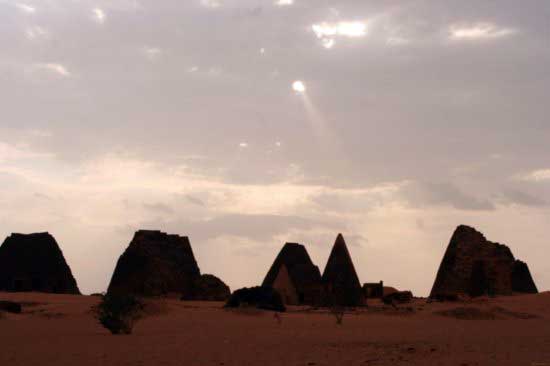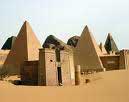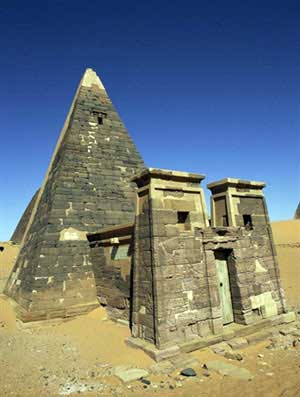|
|

Cemeteries and ancient palaces of the Nubian Desert in northern Sudan hold mysteries to rival ancient Egypt.
Source: Cosmos Magazine
An archeological site 300 kms north of the Sudanese capital Khartoum. The pyramids form one of the most spectacular sights in Sudan with about fifty small ruinous pyramids the tombs of the rulers of Kush from about 250 BC to 350 AD. The pyramids lie on the tops of two rocky ridges blanketed by sand dunes about three miles east of the Nile.
Meroe lies around 200 km northeast of Sudan's capital Khartoum and was the last capital of Kush, also called Nubia, an ancient kingdom centered on the confluence of the Blue Nile, the White Nile and the River Atbara.
Kush was one of the earliest civilizations in the Nile valley and, at first, was dominated by Egypt. The Nubians eventually gained their independence and, at the height of their power, they turned the table on Egypt and conquered it in the 8th century BC.
They occupied the entire Nile valley for a century before being forced back into what is now Sudan.

THE MEROE DYNASTY WAS the last in a line of "black pharaohs" that ruled Kush for more than 1,000 years until the kingdom's demise in 350 AD.
Meroe had three cemeteries containing more than 100 pyramids, smaller than their Egyptian counterparts. The largest are 30 m high and the angles are steep, some close to 70 degrees.
Although the pyramids have been thoroughly excavated, yielding a treasure trove of knowledge about Kushite culture, many aspects of Kushite civilization remain shrouded in mystery for archaeologists.
"We have a chronology, but it's not very precise," says Salah Mohammed Ahmed, deputy director of Sudan antiquities.
Archaeologists have also discovered numerous stelae, or inscribed stone pillars. However, they cannot read the inscriptions.
"We know about 50 words in Meroitic, but we need about a thousand of them to understand a language. So we have an enormous amount of work to do," says Claude Rilly, head of the French section of Sudanese antiquities in Khartoum and a leading expert in the ancient language.
Julie Anderson, an archaeologist at the British Museum and co-director with Ahmed of the Dangeil excavations in northern Sudan, says, "If we manage to decipher this language, a new world is opened to us, as if the ancient Kushites were speaking to us."
Their team recently discovered a massive, one-ton statue of King Taharqa, the most famous of the black pharaohs, who ruled in the 7th century BC.
ALTHOUGH VERY MUCH in Egypt's shadow, Sudan remains a gold mine for archaeologists because it has been far less explored.

"Egypt is fabulous, it is fantastic, but Sudan is a paradise for archaeologists because every time you excavate there, you write a new page in the country's history," says Ahmed, adding that 30 archaeological teams are working in Sudan compared with more than 1,000 in its northern neighbor.
Sudan is full of untouched sites, explains Rilly. "There is an unimaginable number of them to excavate. In some cases, we know that there's something there but we simply don't have enough teams to do the work."
"And then there are sites that are completely ignored, about which we know nothing," she adds.
A few years ago, a team from the Louvre began working at Al-Muweis, about 200 km north of Khartoum, which had been untouched for many years.
"It's absolutely amazing what has emerged. There are several temples, a huge palace and houses, in a place where I would never have thought of finding anything," Rilly says.
Swiss archaeologist Mattieu Honeggar recently discovered a site at Wadi Al-Arab, in a corner of the desert area of north Sudan that was inhabited nearly 10,000 years ago, many millennia before the "black pharaohs," and could allow a better understanding of man's transition to a sedentary lifestyle.

Guillaume Lavallee is a writer for the AFP news agency.